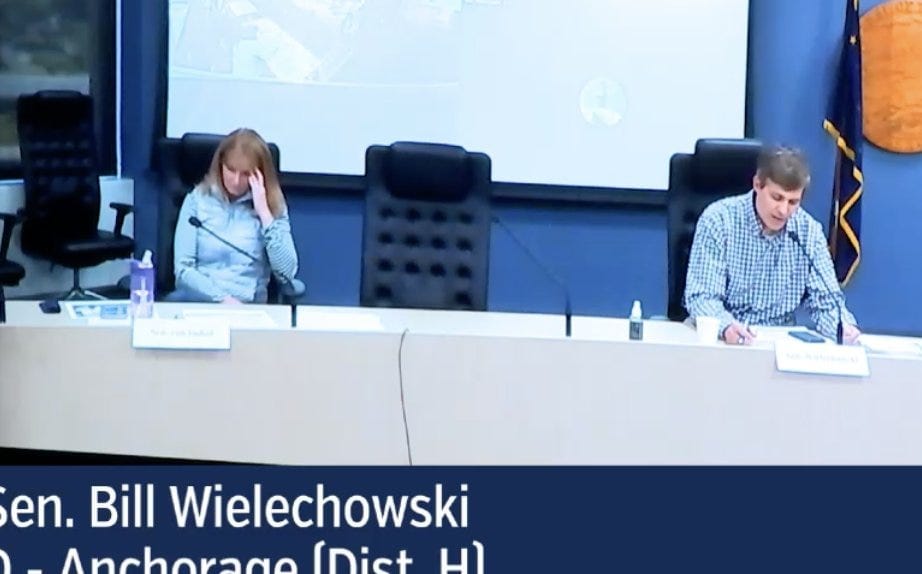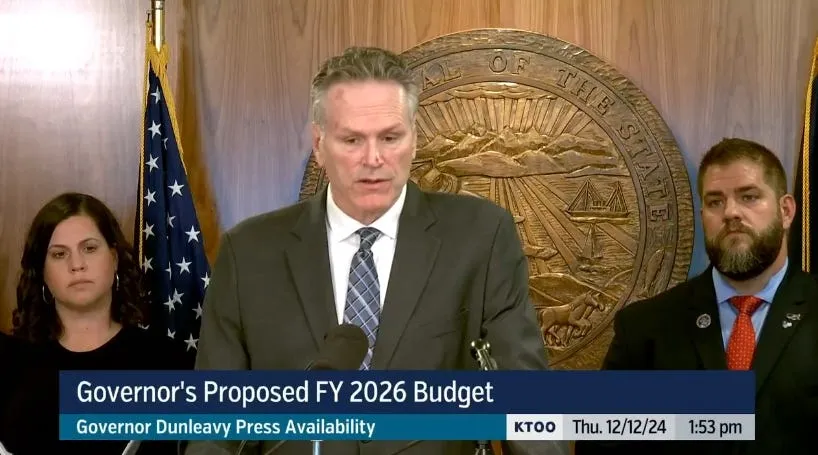'I don’t believe it.' Legislators trash Dunleavy's dividend plan
Several weeks of hearings that have revealed glaring holes and unrealistic assumptions culminated Friday in a Senate Finance Committee hearing where senators took turns trashing the plan.

Happy Friday, Alaska! It’s been, well, quite the week. After nearly 150 days in session, I’ve been dragging this past week but thanks for sticking with me.
‘I don’t believe it.’
Despite all the campaigning state money can buy, Gov. Mike Dunleavy’s PFD plan has not gained any traction and—if anything—has backslid into the realm of the laughable. Several weeks of hearings that have revealed glaring holes, rosy forecasts and unrealistic assumptions culminated Friday in a Senate Finance Committee hearing that can be best summed up with this quote from Sen. Bert Stedman.
“I don’t believe it.”
Stedman and the rest of the Senate Finance Committee drove home the points that have been building in other committees for weeks: No one believes the governor has any idea of how to cut an additional $200 million out of the budget or a clue about how he’s going to either cut or tax an additional $300 million out of Alaskans, pieces necessary for his plan to pencil out. All he’s focused on is running back his 2018 campaign message on the state dime, arguing that he can somehow deliver the impossible of big dividends without significant, painful changes to how state government operates.
“I don’t believe it. I don’t believe it’s going to materialize,” Stedman said of the cuts the Dunleavy administration assumes will happen but cannot be bothered to suggest. “We have spent hours in the conference committee. We were dickering on $16,000 in the conference committee. $16,000! You’re not going to cut $500 million out of this budget in any way shape or form or it would have been done by previous legislators, the current governor or the previous governor. We need to have a shot of reality here.”
As Stedman pointed out, even the painful cuts made in recent years to the University of Alaska and the Alaska Marine Highway System have already been erased by growth in other parts of the budget, like skyrocketing prison costs (Thanks, Senate Bill 91!). Cuts of that scale will likely require the Legislature opening up spending that’s directed by state law, which would mean cuts to things like K-12 funding or Medicaid. But none of that has been mentioned as a possibility by the administration, which has vaguely motioned at efficiencies.
The administration is doing themselves no favors at this point by trotting out the same tired talking points to committee after committee. They’ve continued to act as if $300 million is the totality of the cuts/taxes needed when, in reality, the plan is built on the assumption that the Legislature will make $200 million in cuts over the next two years. Sen. David Wilson, who’s been particularly clear-eyed in his appraisal of the governor’s plan despite being in the bigger PFD camp, raked them over it today, arguing that for transparency’s sake they need to be honest with the total ask in cuts and, also, start coming to legislators with some answers.
“This is the fourth presentation to the Legislature and I think some of the same questions and themes have come up,” he told Department of Revenue Commissioner Lucinda Mahoney. “I was hopeful for not the exact same presentation that we heard earlier in this building but maybe some joyful news that, ‘We heard the Legislature speak about these issues for the last several weeks and we’re working on it.’ We need to have more.”
The answer to any and all questions seeking just an ounce of detail or leadership from the administration has been, time and time again, “Ya gotta wait ‘til the fall special session!” It’s to the point where senators were literally answering each other’s questions seeking answers with “August.” And the fact that the only form of new revenue that Mahoney has mention is gambling is becoming a joke of its own.
“I’m not interested in legalizing gambling, I’m not interested in legalizing prostitution to fix the problem,” Stedman said at one point during today’s hearing. “So, we’ll see what comes to the table.”
Stedman was obviously making a point, but it was still odd that no one explicitly said that legalized sex work is not on the table. Then again, the administration has said they’re doing deep dives on the legality of some “tax-type” revenue measures.
Taxes. It’s been taxes all along!
The state has, roughly speaking, four levers to balance the budget. It can cut the budget, it can raise new taxes, it can reduce the size of the dividend and it can overdraw savings, which would be the Alaska Permanent Fund now they’ve drawn nearly depleted the regular savings accounts. With the state seeing no significant cuts to the state’s bottom line since, and this is kinda hard to believe, the second year of Gov. Bill Walker’s time in office, legislators are putting little stock in that changing any time soon (hence, Stedman’s “I don’t believe you” above). And there’s vanishingly little support for overdrawing the Alaska Permanent Fund when doing so would undermine the future returns on the account and, if we’re being honest, would be the first of many overdraws on the account.
Which leaves the dividend and taxes.
And judging by the size of the dividend in recent years, we know which one has been winning out. Still, with legislators putting forward their own budget/PFD plans in the absence of Dunleavy’s leadership, the push and pull between these two levers has come into fine detail. The key question at the heart of the whole budget debate is really: Are we willing to institute a tax in order to pay out a dividend/fill the budget hole created by paying out said dividend?
Absolutely no way, argues Sen. Natasha von Imhof, the Anchorage Republican who’s been one of the chief leaders of the “No taxes to pay a dividend” movement and has put forward her own plan that balances the budget without instituting a tax to pay a dividend. Like several other legislators, she’s pointed out that the state’s budget does pretty much balance if you pay out a dividend in the range of $500. But isn’t cutting dividends taxes? “It’s less free money,” she argues.
Yes, but not a huge tax, argues Rep. Adam Wool, the Fairbanks Democrat who’s had the guts to propose an income tax in service of maintaining a roughly $1,000 PFD. His plan seeks to shift the burden of government toward the wealthier Alaskans, clawing back the dividend with with a tax on 2.5% of federal gross adjusted income. His side also argues that it would solve a fundamental problem with how the state’s budget has grown disconnected from the economy.
What’s been particularly interesting about all of this is not just the question of “Who pays” but of what, exactly, is fair and equitable. Dunleavy’s team claims the 50-50 dividend is equitable… because they say it’s equitable. But, again, what exactly is equitable? How do we define that?
Legislative Finance Division Director Alexei Painter has closed his recent presentations by asking legislators to think about their long-term goals with considering solutions for the budget. Do you think oil prices will continue to rise? Do you think we should be saving in case it goes down? Do you want to implement taxes in service of paying a dividend? Do you think additional cuts are possible? How do you want to balance it?
… and oil taxes
And, as Sen. Bill Wielechowski pointed, out: There’s always oil taxes.

Welcome to Bronsonville, Population 1,000
With conservative incoming Anchorage Mayor Dave Bronson three weeks away from taking office, there’s a fair bit of guarded optimism that he won’t, in fact, be the living embodiment of Save Anchorage. Let’s be clear, the bar and expectations for this guy are extraordinarily low but the fact that he’s going to be keeping on Anchorage Police Chief Ken McCoy and picked up Doug Schrage as chief of the Anchorage Fire Department are both considered to be promising signs that his administration won’t be governing with the chief goal of owning the libs.
Even his proposal for a 1,000-bed “dome-like” homeless shelter in East Anchorage was not met with instant and widespread derision from all corners (some corners, but not all). This was a guy whose campaign largely revolved around demonizing the homeless to the point where Ron “I didn’t spray poison on the homeless, I merely sprinkled poisonous chemicals on the homeless” Alleva as homelessness director was considered plausible. But as folks have pointed out, the idea of housing homeless people and providing them the services necessary to get back on their feet has pretty much been the progressive playbook for the last six years. A 1,000-person shelter is ludicrous as it would densely concentrate people into a target for drug dealers and traffickers, but something smaller and more spread out could certainly find some traction.
Again, the expectations are incredibly low for Bronson and he’s still weeks away from taking office, but the general thinking is that he’s at least going through the motions of being interested in governing. I’m also one of the first to give people the unearned benefit of the doubt, but there's a world where conservative governance can work, but it takes real, earnest efforts at governing… something that’s been notably lacking with President Donald Trump and Gov. Mike Dunleavy. But then again, we haven’t seen what kind of sole-source contracts Bronson could get up to.
Really, at the heart of it is that Bronson won by a slim margin and faces an assembly who had by and large supported his opponent... who will still be on the assembly.
Weekend reading
- The end of the session brought a pause to the fight over Alaska’s election laws, but it hasn’t stopped some very smart people from thinking about how to chart a course on Alaska’s election laws. One of the really critical things to consider here is that election policies aren’t quite as clear cut partisan as people like to think. Broader ballot access helps everyone while putting up impediments—like multi-factor authentication—can hurt your own side, too. From the Sightline Institute: Alaska’s lawmakers have a bipartisan election fix at their fingertips
- Alaska’s oil industry has a bit of whiplash under the Biden administration. First, Biden sided with the Willow project only to turn around and put a pause on ANWR. Here’s a good breakdown of the big picture and what’s next. From Alaska Journal of Commerce: Without options in Congress, Murkowski urges lawsuit over ANWR
- With Olympic trials right around the corner, there are a lot of Alaska athletes looking to punch their ticket to Tokyo. But for running star Allie Ostrander, the last few months have had a very different focus. In a 17-minute video, Ostrander talked about the challenges and treatment she’s been facing with a long-term eating disorder. Such admissions are rare in top-level athletes, but it’s an important and earnest look behind the curtains of high-level competition. From the ADN: Alaska running star Allie Ostrander says treatment of a long-term eating disorder is her priority as Olympic Trials approach
And now for something completely different
Lo-fi Tlingit.
Have a nice rest of the weekend, y’all.
The Alaska Memo Newsletter
Join the newsletter to receive the latest updates in your inbox.




